| Back to search results » | Back to search page » |
|
Inverleigh Precinct
LocationHamilton Highway INVERLEIGH, GOLDEN PLAINS SHIRE LevelIncluded in Heritage Overlay |
|
Statement of Significance
What is significant? The township of Inverleigh is located on the Hamilton Highway approximately 28 kms west of Geelong. It is nestled within a curve of the Leigh River, approximately 1 km north of the junction of the Leigh and the Barwon Rivers. The township was officially proclaimed in 1855, following a crown survey undertaken in 1854. It is laid out in a conventional grid aligned north-south to east-west on the western side of the Leigh River. The early settlement of Inverleigh is associated with the Derwent Company's runs of the 1830s and 1840s. The Company laid claim to 26,000 acres of land in the Portland Bay District. When it was dissolved in 1842 its properties were divided up by mutual consent and pastoral runs such as Native Hut No. 3 and Weatherboard Nos. 1 & 2 were formed within the Inverleigh area. The new owners continued to be important patrons of the town. The Inverleigh township developed during the 1850s as a commercial and civic centre servicing surrounding pastoral properties. It was also an important stop on the colonial trade routes that linked Geelong to the Western District and the Woady Yaloak goldfields to the north. At first, a gravel ford provided access across the Leigh River. After the completion of a permanent bridge over the Leigh River in 1853 and the formalization of the township grid, High Street became the primary route into and out of town. The bluestone abutments survive but the bridge has been superseded by a modern structure. An impressive avenue of Cupressus macrocarpa (Monterey Cypress), established in the early twentieth century, signals the Hamilton Highway's eastern and western entrance. Important public and commercial buildings were established during the 1860s, such as the township's two bluestone hotels, a post and money order service, a Mechanics Institute, four churches and three denominational schools. The division of large pastoral properties at the end of the nineteenth century gave way to intensive agricultural activities such as dairy and horticulture. A farmer's common was established to provide inhabitants of the town access to pasture for the grazing of cattle and horses. Orchards originally established to supplement dairy farming developed into large commercial operations, supplying jam manufacturers located in Geelong. The Gheringhap to Maroona railway line was completed in 1910, with local produce dispatched from the Inverleigh Railway Station. While surrounding townships experienced a decline in population and services during the mid twentieth century, Inverleigh struggled but survived. In the 1950s the townships population was 250 persons, with an increase to 350 persons recorded in the 1960s. During this period the township had a post and telegraph office, State School, savings bank, four churches, a public hall, police station, electric lighting and football, cricket, golf and tennis clubs. By the 1970s the public hall was extended to incorporate a baby health care centre and medical clinic. The township of Inverleigh remains substantially intact and the surviving buildings and infrastructure from a range of periods retain a high degree of integrity. Key public buildings, open public spaces and surviving examples of commercial and residential development provide a clear sense of past and present settlement. How is it significant? The township of Inverleigh is of historical, architectural and social significance for the Golden Plains Shire.
Why is it significant? The township of Inverleigh is of historical significance as one of the many small settlements in the Shire established to support agricultural industries during the 1850s and 1860s. It has direct associations with members of the Derwent Company and subsequently the Willis and Berthon families and Dr. Robert Cuthbertson Hope, pioneer pastoralist and medical doctor. It is of architectural significance for its range of commercial, residential and public buildings dating from the nineteenth century and some designed by architects. The town is of social significance as the focus of community life, religions activity, education and recreation.
Group
Community Facilities
Category
Hall Town Hall




